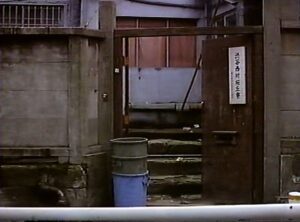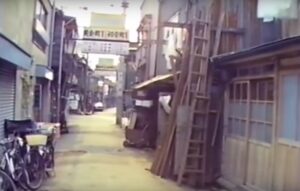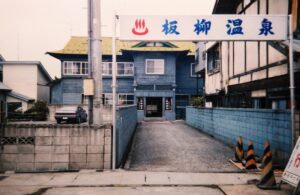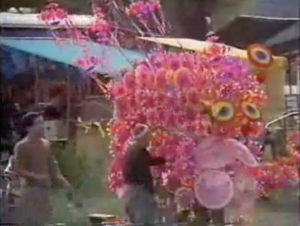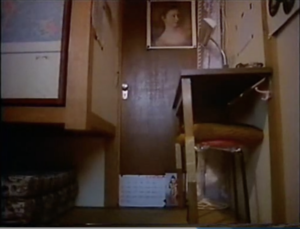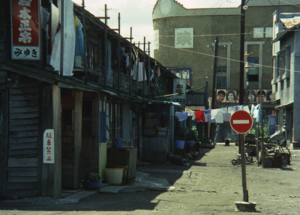By Shayne Bowden
© all rights reserved. Printer friendly PDF version.
In 1969, Japanese filmmaker Adachi Masao (1939-) along with fellow members of the film/activist group Hihyō Sensen set out to make an experimental documentary on the recently arrested spree killer Nagayama Norio. The film was entitled Ryakushō Renzoku Shasatsuma. Their methodology was to film only the locations or landscapes that Nagayama had experienced throughout his life in a chronological order. Unlike a conventional documentary, there are no interviews, no central human subjects, only the actual locations that Nagayama was born into and lived through up until his arrest. Nagayama does not appear in the film. As a cinematic manifestation of the contemporaneous Japanese theoretical discussion of landscape (known as fūkeiron),[1] banal urban space is represented as the subject, foregrounded regardless of seeming irrelevance and utilised as a framing and concentration of the dynamics of state power that permeates and regulates both visible and invisible quotidian space. As well as this visually unorthodox approach to the film’s subject matter, the documentary rejects an actual synchronised soundtrack and instead uses a free jazz soundtrack as the sole aural accompaniment to the chronological telling of Nagayama’s life as it unfolds as pure landscape. Ryakushō Renzoku Shasatsuma is as much an experiment of film sound as it is an experiment of the documentary film form itself. Both sound and image are utilised to expose and identify spatial power dynamics.
Ryakushō Renzoku Shasatsuma (A film about nothing)
In 1969, twenty-year-old Nagayama Norio was arrested for the random murder of four individuals by gunshot at various locations in Northern and Central Japan during the previous year. The arrest attracted much media attention in Japan due to his age and the sporadic nature of the spree killings. Nagayama’s public profile quickly became a narrative determined by official police reports which were then sensationally reported by newspapers, magazines, radio and television. The youth from the extreme north of the Japanese archipelago became known as the ‘Pistol Killer’ and the reportage generally covered press conferences held by police, footage of murder locations, on-screen maps of the various locations across Japan and interviews with police and relatives. The accumulation of visual/textual information was a response to a public curious to know why a young man would kill complete strangers for no reason throughout Japan, shattering belief in the popular narrative of national social stability and safety.
Shortly after his arrest, a group of writers, theorists, filmmakers and activists decided to produce a documentary on Nagayama’s life with the purpose of investigating Nagayama independently and in a manner distinctly unlike that of the popular reportage that was attempting to form the common perception of the man, his life and criminal motives. The documentary would be a cooperative collaboration between the group members who would later become known as Hihyō Sensen or Frontline Criticism. Although a collaborative film project the actual directorial duties were granted to Adachi Masao who had already made multiple independent films associated with the Japanese avant-garde and also Pink film genre.[2] As with other Hihyō Sensen members, Adachi was a prolific essayist, activist and also screenwriter who had written screenplays for Wakamatsu Koji and Ōshima Nagisa and probably the most technically capable individual on hand to direct the documentary.
The historical context is that this was a tumultuous era of mass anti-government protests in urban centers throughout Japan that involved student activists, unions and regular citizens. Towards the end of the 60s, the spectacle of tens of thousands of people publicly demonstrating in Japan was not uncommon. Televised popular protest and open dissent greatly upset the government’s public image and additionally created an awareness of the government’s subservient relation with the United States, especially in regard to the continuing presence of US bases in Okinawa and elsewhere. Government responses that attempted to demonise public dissonance were increasingly at odds with growing public opinion that was sympathising with demonstrators after seeing images of participants being beaten by police and government-hired right-wing thugs. Sensationalism, became the media tactic to maintain attention and consumption of television, radio and print media related to Nagayama’s arrest. Adachi and the Hihyō Sensen group decided to experiment with the documentary form and attempt an alternative modality of reportage that shunned the orthodox and familiar methodologies of popular media in order to form their own knowledge of Nagayama and his life.
Ryakushō Renzoku Shasatsuma is an 86-minute colour 35mm film that comprises footage of quotidian urban landscapes. There are shots of ramshackle houses, train stations, city and rural streets and thoroughfares. As well as exterior landscapes there are occasional sequences of interiors such as Nagayama’s apartment and his places of employment. These scenes are at times empty of people, and when there are people in the shot they are shown from a static long-shot perspective that has the observational qualities of actuality cinema.[3] There are sequences showing overviews of industrial areas, ports, military bases and shrines. All of the spaces shown, that float into view, represent the actuality of Japan some 29 years after the end of World War II. It shows a functioning, somewhat prosperous post-war society (encompassing both modern and traditional facets of social and cultural life in Japan) that is regimented and orderly. However, all of these scenes of the unremarkable everyday, regardless of their banality, have a relation to one of the most famous crime cases in Japan. All of the sequences in Ryakushō Renzoku Shasatsuma are shots of locations that Nagayama Norio was born into, lived in, worked in, travelled across and also committed murder in. Further, according to Adachi, all the locations that he and the crew visited and filmed began to look visually similar by design. As filming progressed, institutions, infrastructure and urban landscapes in general began to resemble each other regardless of location in the Japanese archipelago. As well as this, cultural and religious practice and ritual gradually began to show similarities and repetitiveness regardless of the town or city they belonged to. This by extension implies (according to the main contention of fūkeiron) that the people that dwell within these landscapes are, as with the landscapes themselves, controlled and regulated and that this commonality by design brought about a new sense of ‘suffocation’ due to the sense of state power permeating all lived space and experience [Figures 1-7].
A concession to conventional documentary filmmaking was made by Adachi for the sake of narrative exposition. It was decided that these chronologically ordered landscapes were to be signposted by a series of voice-overs (with inter-titles) that would provide an oral and textual account of Nagayama’s biographical history and from which an association between landscape and Nagayama would be established. In Ryakushō Renzoku Shasatsuma, the voice-over is perhaps the most orthodox documentary technique employed, as without it the film would be a succession of banal urban spaces relegating the film to abstract/experimental cinema. The voice-over helps to materialise the figure of Nagayama, to place him within the film’s narrative even though he is absent. In this sense Nagayama could be representative of any individual of the lumpenproletariat, or so it is suggested by the film and its related discourses.[4] However, the voice-over also inadvertently reveals the subjective position of the filmmaker(s). The make-up of the voice-over is firstly male/masculine and has an authoritative tone. It is disembodied (‘voice of God’), asserts both a knowledge of the subject and that its content is informative and non-fictional. The voice-over in Ryakushō Renzoku Shasatsuma succeeds in elucidating the biographical details of Nagayama’s life but does so while interrupting the music track and severing the flow of a favourable merging of sound and image within a poetic mode of documentary filmmaking.
The Soundtrack
Synchronous sound is a convention of both fiction and non-fiction film that matches sound with image. Ryakushō Renzoku Shasatsuma uses a free jazz soundtrack instead of a synchronous soundtrack recording of the film’s visuals.[5] As with the absence of the documentary’s subject, Nagayama Norio, the actual sounds of the landscapes shown in the film are also omitted. During December of 1969, the soundtrack by drummer Togashi Masahiko and saxophonist Takagi Mototeru was recorded as three improvised sessions using drums, vibraphones, marimba, tubular bells, timpani, tenor saxophone and bass clarinet. Togashi and Takagi were established and respected young jazz musicians who had ventured from traditional jazz to free jazz composition and performance. Adachi approached Togashi and asked him to create a soundtrack for an experimental documentary on Nagayama Norio and stressed that the music should not adhere to conventional forms and instead be a substitution for actual synchronous sound. Togashi and Takagi recorded the tracks after discussions with Adachi about the primacy of landscape in the film. They also watched a segment of footage from the documentary (Adachi and Hirasawa 296). They approached the sessions with the idea of expressing what they felt in regard to Nagayama’s frame of mind, his various mental conditions from childhood onwards in a chronological manner similar to that of the film (296). The result is non-synchronous soundtrack that plays over the entire film and creates a harmonious relation between sound and image. The music and timing of its aggressive and mellow textures avoids a discordant visual and aural relationship that would follow from a synchronous atmosphere track continually changing with each edit or cut from scene to scene. The pair compliment the flow of the images without reverting to repetitive time signatures. Ironically, the incongruous sound textures emanating from the duo’s instruments assist the rhythm of the images and allow an aesthetic thread to develop that connects sound and image while avoiding cliché and orthodoxy. The soundtrack by Togashi Masahiko and Takagi Mototeru adds a musical cohesion to the images whether it be harsh combative drum and saxophone textures (over images of a departing subway train shot from the trains interior) or solitary and gentle flute or marimba sounds over images of empty locked down streets in Shinjuku. Soft tones and quiet interludes over images of people in parks eating lunch and resting on the grass may suggest introspection. The raucous interlocking of saxophone screams with cymbal crashes and drum rolls may suggest a sense of overwhelming bombardment of the senses by the actual visual and audible make-up of Japanese urban landscapes. Scenes with heavy traffic and urban life utilise harsh musical sequences. The soundtrack therefore replaces matching actual atmospheric sound recordings with an interpretation or musical appropriation of the rhythms of the landscapes that Nagayama experienced. The soundtrack as an oppositional force, substituting the actuality of urban landscape’s aural environment nonetheless provides a consistent refrain of sound, placed over the film’s visual survey of post-war Japanese landscape. Those sounds of urban space in Japan are re-inscribed with jazz as an activist proposition (as it indeed was in Japan during the 1960s) aurally texturing this particular cinematic representation of state-designed quotidian urban space.
This flowing, harmonious disjuncture is not unlike the usage of sound in the work of Russian director Dziga Vertov.[6] Like Vertov, Adachi utilises the soundtrack as a means of exposition. Writing on Dziga Vertov’s use of sound in the article, Enthusiasm: From Kino Eye to Radio Eye, Lucy Fischer discusses Vertov’s theoretical approach to sound and image in relation to his 1930 documentary Entuziazm: Simfoniya Donbassa (Enthusiasm: The Symphony of Donbass). Fischer mentions Vertov’s belief that ‘the masses must be educated and conscious of the social, economic and political workings of the Soviet state’ (Fischer 27). Further, Vertov believed that with the limitations of the basic ‘human perceptual apparatus’, people are ‘handicapped’ in regard to their ability to make sense of the complex social dynamics of existence and experiences, the ‘visual chaos’ of the modern world, no matter how familiar and mundane (28). Vertov regarded machines such as cameras and devices for recording sound as being able ‘to perceive life, and furthermore, to organize its chaos into a meaningful whole’.9 This would then enable cinema, ideally, through a careful and thoughtful severing of matching sound and vision to instead juxtapose sound and vision that subverts a ‘naturalistic illusion’ .
Vertov in his radical concern with mass consciousness wants the viewer of his documentary films to be continually aware that he is watching a film. He wants to break the mesmeric spell of the cinema to ensure its didactic powers. If the masses watch a play-film even with approved socialist content, they may be swayed by the powers of the medium, and its actors, and not persuaded intellectually, by the truth of its arguments. For Vertov the people must have knowledge and not belief, and to assure this, one must subvert the power of cinematic illusion. (Fischer 28)
There are two points made in the above quote that correspond with Adachi’s use of sound and image in Ryakushō Renzoku Shasatsuma and also with fūkei cinema as a modality of elucidation in regard to depicting state power and its invisible dynamics in space for cinema audiences. Adachi, by negating synchronous and matching sound and vision instead merges experimental and non-fictional film, breaking ‘the mesmeric spell’ of cinema. He then further guides the viewer into landscape by way of voice-over signposting. This necessitates a spectatorial contemplation of filmic space not as a site of (suspended) disbelief but instead as a site of potential knowledge becoming a dual dynamic that develops alongside a possible sense of Nagayama’s specific subjective perspective. The perspective, although suggested, is dependent upon the landscapes that the viewer is guided to via the camera that is placed in the actual physical spaces that Nagayama inhabited. In this sense, Adachi’s use of sound in Ryakushō Renzoku Shasatsuma shares with Vertov’s sound and image theory an attempt to coerce a contemplation of ‘visible chaos’ and provoke an awareness of its dynamic workings in the everyday.[7] It follows from a rich history of political activist and experimental cinema that was created in response to historical socio-political milieus as was Ryakushō Renzoku Shasatsuma to the social and political environment of 1960s Japan. The soundtrack itself by Togashi Masahiko and Takagi Mototeru is of this specific milieu as well, of course, and even without the association with the film, the music by Togashi and Takagi remains as a sublime stand-alone moment of Japanese free jazz.
Ryakushō Renzoku Shasatsuma was not shown publicly until some years after the film was completed, a delay perhaps due to the intention of the filmmakers being to simply explore the experimental boundaries of a biographical documentary film. The development of the conceptual framework and actual execution of the film took precedence over public screenings and distribution. Following the film’s completion, the Hihyō Sensen group focused on the monthly publication of the radical film magazine Eiga Hihyō. Group member Matsuda Masao wrote prolifically on fūkeiron in various film journals while Adachi Masao produced and co-wrote several pink eiga films before traveling to Lebanon with Wakamatsu Koji to film the 1971 documentary Sekigun-P.F.L.P: Sekai sensō sengen. Ryakushō Renzoku Shasatsuma was eventually screened some years after its completion at the Maison Franco-Japonais in Ochanomizu, Tokyo. The soundtrack for the film (retitled Isolation) had been released on Columbia Records in 1971, before the film was screened for an audience and as the record version of the soundtrack contained only two parts of the recorded soundtrack there was anticipation for fans of the soundtrack to hear what until then had been unheard. According to jazz journalist Soejima Teruto, who was in the audience for the initial screening, there were ‘a lot of people in the audience with small tape recorders in their hands’ ready to record the soundtrack in its entirety (Soejima 84-5).
The 4’33” Connect (A Concert About Nothing)
I want to conclude with some brief thoughts regarding the suggested theme of this special section of AHR, John Cage’s 4’33”. This is because I sense a framing device that both Ryakushō Renzoku Shasatsuma and 4’33” utilise in order to bring to the fore the otherwise imperceptible or simply unstated spaces and sounds that permeate the audible chaos of everyday experience. Cage’s 4’33” is a composition that is dependent upon a pre-designed durational framing. 4 minutes 33 seconds is the extent of time that the listener or listener/viewer is forewarned of—the extent of the nothingness that is about to unfold. The time commences with a signal that the dynamics of a composition that is not played can instead become a time for the listener to interact with and identify the aural dynamics of a performance space devoid of played music. I suggest that just as Adachi Masao’s 1969 documentary Ryakushō Renzoku Shasatsuma presents landscapes without synchronic sound as a lure to reconsider the visual dynamics of often neglected but ever present banal urban spaces, so, similarly, Cage’s composition offers an opportunity for concentration upon and familiarisation with the dynamics of everyday ‘unintentional’ sounds. The (time-framed) silence reveals the actuality of an auditory environment and the sensory dynamics existing therein. Nevertheless, it is a frame very much unlike the film frame.
The framings utilised in these two works differ, as one is spatial and one is temporal. Ryakushō is essentially a silent film that is dependent upon an accompanying score. 4’33”, when experienced ‘live’, has a visual element insofar as the audience that is denied performed music must still gaze upon the instrument(s) and player(s) to verify an ongoing performance of nothingness that leads to a realisation of both the absence of music and presence of other sounds. Both works form territories. Giles Deleuze refers to the film frame as a ‘closed system’ that contains all elements of the shot within a defined and bordered space. It is for a Deleuze a saturated and rarefied space depending on the intensity of a space as enlarged or reduced by the camera lens. The frame creates a filmic territory (Deleuze). The soundtrack to the film (regardless of interrupting voice-overs) becomes a refrain that compliments its territories and substitutes for an actuality that has no actual synchronous sound. Mary Ann Doane writes that (film) ‘sound is not “framed” in the same way as an image. In a sense, it envelops the spectator’ (Doane). 4’33” uses a performative temporal frame that enables an awareness of frameless aural expanse.
As Cage asserted, and as is a primary goal of this conceptual composition, there is no silence regardless of an unplayed piano before a seemingly silent audience. The absence of piano sound and the presence of a cacophony of actual audible sounds, timbres, acoustics, reverberations, songs, noises and distant screams, permeate the everyday. Further, sound saturates space even when the space is absent of people. Hearing is essential to this declaration of sound filled silence as is sight to the experience of eventless landscapes. Those devoid of those senses will rely on other sensory channels. Touch is a sense that comes to mind, the haptic.
Thanks to Monique Rooney, Fergus Armstrong and Robert Worby.
Shayne Bowden is a PhD candidate in the School of Languages and Cultures at the University of Sydney. His Master’s research was on Japanese landscape theory and the cinema of Masao Adachi and Ōshima Nagisa. In 2020, he received the AR Davis Memorial Scholarship for his current research on the spatial and historical transition of film locations in the Shinjuku area of Tokyo. Shayne was the curator of the AGAINST music and film festival in Fukuoka City Japan from 2008 until 2018 and is the director of deterra, which has organised and curated music, film and art events in Japan since 2003. His other research interests include Japanese avant-garde music and performance and Australian New Wave cinema.
Notes
[1] Fūkeiron or (Landscape Theory) was a discussion of space and power amongst artists and theorists in Japan during the late 1960s and early 1970s. Landscape was seen as an extension of power and governmentality regardless of how banal and seemingly uneventful. Photographers such as Nakahira Takuma and Daidō Moriyama, filmmakers Adachi Masao and Ōshima Nagisa and theorists and activists such as Matsuda Masao discussed how landscape could be re-understood and used as an activist modality to counter state control and regulation.
[2] Pink Film is a genre of soft pornography that enjoyed popularity during the 1960s and 1970s. There were many anti-establishment Pink films produced in the 1960s as producers would finance any scenario as long as it adhered to the requirements of the genre. See Sharp.
[3] ‘Actuality cinema’ refers to non-fiction film, particularly that of the silent era, when cameras would simply observe everyday phenomena that until then had not been filmed. The Lumière Brothers are often associated with actuality film, a famous example of which is La sortie des usines Lumière (Workers Leaving the Lumière Factory) (1895).
[4] This is a central proposition put forward by the film and the contemporaneous discourse of fūkeiron. Could landscape as a physical extension of state power play a role in Nagayama’s life trajectory that culminated in murder? I say ‘proposition’ because to state or assert that landscape coerced or influenced Nagayama in relation to his murder of four individuals can easily veer the discussion towards apologetics and environmental determinism.
[5] Free jazz is a genre of jazz that experiments with conventional scales, time signatures and tones and hence ‘free’ composition and performance from rigid conventions often associated with bebop. Some of the earliest practitioners of this genre of jazz include Ornette Coleman, Albert Ayler and Cecil Taylor. Free jazz as a genre was well known to the members of the Hihyō Sensen group especially with individuals with musical backgrounds such as Aikura Hisato (Aikura had initially suggested that jazz pianist Yamashita Yōsuke provide the music for the Ryakushō soundtrack). Adachi was also a regular at the Village Vanguard jazz bar where Nagayama was for a time employed. Some of the earliest practitioners of free jazz in Japan would include Takayanagi Masayuki, Togashi Masahiko, Yamashita Yōsuke and Abe Kaoru as well as many others. Although Japanese free jazz was influenced by American and European practitioners the form as realized in Japan is distinct in its ferocity. The Japanese free jazz scene of the 1960s has substantial connections to the radical politics of the day and other contemporaneous avant-garde movements in Japan during that era. See Soejima.
[6] Although Adachi was aware of Vertov’s oeuvre he makes no mention of any direct influence of Vertov’s similar usage of sound and image when discussing the soundtrack with Hirasawa Go in the biography Eiga/Kakumei (Film/Revolution) (Adachi and Hirasawa).
[7] Yuriko Furuhata has discussed ‘the exteriority of the spectator to the image’ in regard to Ryakushō Renzoku Shasatsuma and also another film by Ōshima Nagisa that is also regarded as a film of the fūkei cinema experiment, Tōkyō Sensō Sengo Hiwa (1970). Both films have sequences comprising seemingly unrelated banal urban scenes that lack a protagonist to lure any spectatorial investment in a narrative. The composition of shots where the camera simply observes urban space without penetrating the filmed space for the sake of narrative exposition further relegates the bound observational exteriority. Hence the voice-over signposting in Ryakushō and the relegation of pure landscape in Ōshima’s film to a film within a film sequence embedded in the films fictional storyline. Further, the use of a non-synchronous, jazz soundtrack alienates the viewer from synchronous sounds and images, from sensory actuality itself. See Furuhata.
Works Cited
Adachi, Masao, and Hirasawa Go. Eiga/Kakumei. Tokyo: Kawade Shobo Shinsha, 2003.
Andrews, William. Dissenting Japan: A History of Japanese Radicalism and Counterculture from 1945 to Fukushima. London: Hurst and Co., 2016.
Belton, John, and Elisabeth Weis, eds. Film Sound: Theory and Practice. New York: Columbia University Press, 1985.
Deleuze, Gilles. Cinema 1: The Movement-Image. Minneapolis: U of Minnesota P, 2001.
Doane, Mary Ann. ‘The Voice in the Cinema.’ Film Sound: Theory and Practice. Ed. John Belton and Elisabeth Weis. New York: Columbia UP, 1985. 565-78. Originally published in Yale French Studies 60 (1980): 33-50.
Fischer, Lucy. ‘Enthusiasm: From Kino-Eye to Radio-Eye.’ Film Quarterly 31.2 (Winter 1977-1978). 25-34.
Furuhata, Yuriko. Cinema of Actuality: Japanese Avant-Garde Filmmaking in the Season of Image Politics. Durham: Duke UP, 2013.
Nichols, Bill. Introduction to Documentary. Bloomington: Indiana UP, 2017.
Sharp, Jasper. Behind the Pink Curtain: The Complete History of Japanese Sex Cinema. London: Fab Press, 2008.
Soejima, Teruto. Free Jazz in Japan: A Personal History. Trans. Kato David Hopkins. Nara: Public Bath Press, 2018.
Worby, Robert. ‘Robert Worby on John Cage’s 4’33”.’ The Essay 4 January 2016. BBC Radio 4. <https://www.bbc.co.uk/programmes/b06tks32>.

